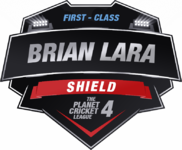Owners Update: Home Grounds and Pitch Types
@CerealKiller /
@Parth D /
@AsadRM |
@Till Valhalla /
@WutUpMahGlipGlops |
@Ashutosh. /
@Manish. /
@Bilal45 |
@AJ MODS /
@Life Warrior /
@VDQuint
In addition to finalizing your "Homepages etc. in your team thread" , kindly start thinking about your Home Ground (Name and location) and pitch type.
Pitch Types: Choose one pitch type per format (First-Class / List A & T20) that your groundman and staff will prepare for the matches.
#1 Dead Pitch
A dead pitch is entirely flat with absolutely no grass or moisture on the surface. The continuous rolling on these pitches removes the grass and moisture, and these dark pitches are best suited for batsmen as it doesn't assist the spin or pace bowlers. The subcontinent consists of a majority of the dead pitches, which are especially seen during limited overs matches.
A dead pitch is not the best suit for Test wicket as it makes it extremely challenging for bowlers to take wickets. A high-scoring Test match ordinarily consists of these types of wickets with no grass or moisture. However, this is an ideal pitch for an ODI or T20 match as these wickets have nothing to offer for the bowlers. It assists the batsmen to score plenty of runs on the scoreboard and the games played on these kind of wickets tend to have a high score from both the teams.
#2 Green Pitch
Dream pitch for seam bowlers
The grass cover on these pitches enables movement for fast bowlers. Green pitches are a dream surface for seam bowlers as they can showcase their swing and pace prowess. However, they can cause a significant threat to the batsmen. These wickets have a grass cover on the good length area causing the ball to move and swing after pitching on the surface.
England, South Africa and Australia have a lot of grounds that boast of such pitches which enables their best bowlers such as Anderson, Steyn or Starc to wreak havoc on the opposition.
Green pitches are ideal for Test matches as they examine the temperament of batsmen against seam and swing bowlers. The grass on the pitch reduces the roughness of the surface that allows the ball to swing regularly thereby testing the batsmen's technique. However, this pitch doesn't accommodate for spinners as the ball doesn't grip the surface.
#3 Dusty Pitch
Suitable conditions for a spinner
The primary characteristic of a dusty pitch is that it is soft. A dusty pitch is easily the best wicket for a spinner as pitches are left unrolled, that allows the ball to grip. They are ideal for spinners as the ball tends to grip the surface allowing it to turn a lot more than the other wickets.
However, these pitches have predictable or low bounce making it easy for batsmen to score runs once they adjust themselves to the conditions. Similar to a dead wicket, the subcontinent conditions favour dusty pitches. For these reasons, the Indian cricket team is known to rely on their spinners to obtain wickets in home conditions.
#4 Normal Pitch
A balanced pitch equally favours both, the batsmen as well as the bowlers. The perfect blend of runs and wickets. The best thing about a balanced pitch is that on any given day, it can turn out to a turner or a green field. A run deck or a dead runner. In the words of the Mad-Titan Thanos, perfectly balanced as all things should be.
An even pitch is suitable for all the three formats. In the coming years, we have seen grounds like The Lords and MCG adopt a balanced pitch in the limited overs fixtures. The most ideal thing to do is to go with a perfectly balanced line up of 5 batsmen, 1 keeper, 2 all rounds and 3 bowlers.
A balanced pitch is like having three pitches in one altogether. An equal contest between bowl and bat as well. (Credit:
@Parth D 
)















 )
)



